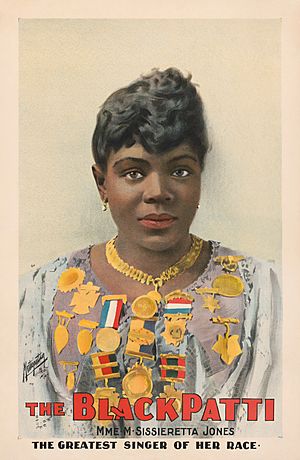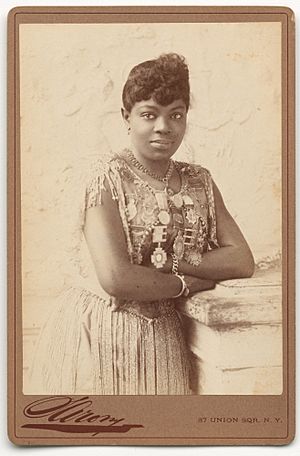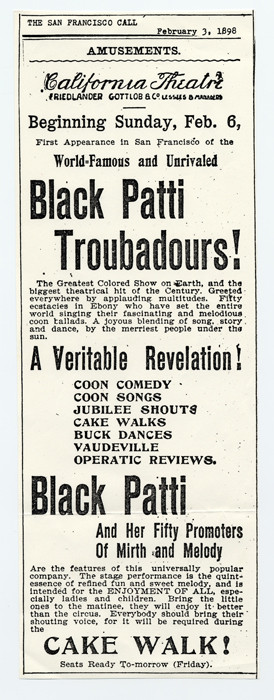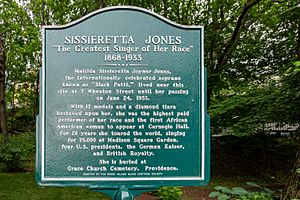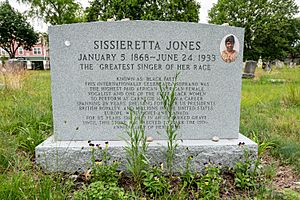Sissieretta Jones facts for kids
Quick facts for kids
Sissieretta Jones
|
|
|---|---|
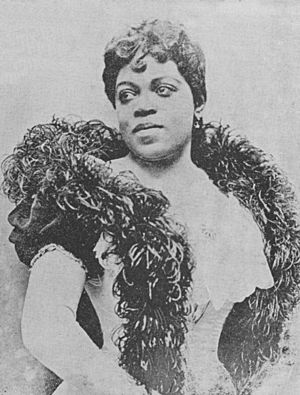
Jones in 1897
|
|
| Background information | |
| Birth name | Matilda Sissieretta Joyner |
| Also known as | The Black Patti |
| Born | January 5, 1868 Portsmouth, Virginia, U.S. |
| Died | June 24, 1933 (aged 65) Providence, Rhode Island, U.S. |
| Genres | grand opera, light opera, popular music |
| Years active | 1887–1915 |
Matilda Sissieretta Joyner Jones (born January 5, 1868 or 1869 – died June 24, 1933) was an American soprano. A soprano is a singer with a very high voice. She was sometimes called "The Black Patti". This name was given to her because she was compared to the famous Italian opera singer Adelina Patti. Jones sang many types of music. These included grand opera, light opera, and popular music.
Sissieretta Jones studied music at the Providence Academy of Music and the New England Conservatory of Music. She first performed in New York in 1888. Four years later, she sang at the White House for President Benjamin Harrison. She later sang for four different presidents and the British royal family. She became famous around the world. Jones toured in the United States, the West Indies, South America, Australia, India, southern Africa, and Europe.
Sissieretta Jones was the highest-paid African-American performer of her time. Later in her career, she started her own group called the Black Patti Troubadours. This group later changed its name to the Black Patti Musical Comedy Company. It included 40 jugglers, comedians, dancers, and 40 trained singers. She was the main star of the Famous Troubadours for about 20 years. They became very popular in major cities across the United States and Canada. Jones stopped performing in 1915. In 2013, she was honored and added to the Rhode Island Music Hall of Fame.
Contents
Early Life and Music Training
Matilda Sissieretta Joyner was born on January 5, 1869, in Portsmouth, Virginia. Her father, Jeremiah Malachi Joyner, was a minister. Her mother, Henrietta Beale, sang in a church choir. Her father had been enslaved before, but he learned to read and write. Matilda was the oldest of three children, but her siblings died young.
Her family and friends called her Sissy or Tilly. She started singing at home when she was very young. When she was six, her family moved to Providence, Rhode Island. There, she sang in her father's church. She also went to Meeting Street and Thayer Schools. In 1883, Joyner began to study music formally at the Providence Academy of Music. She also studied at the New England Conservatory of Music and the Boston Conservatory.
Becoming a Star Singer
First Performances and Big Break
On October 29, 1885, Jones sang alone in Providence. This was before a play called Richard III. In 1887, she performed at Boston's Music Hall for 5,000 people. Her first performance in New York was on April 5, 1888.
A manager for Adelina Patti saw Jones perform. He suggested that Jones tour the West Indies with the Fisk Jubilee Singers. Jones had successful tours in the Caribbean in 1888 and 1892. Around this time, a writer called her "the Black Patti." Jones did not like this name. She preferred to be called Madame Jones. She once told a reporter that the name "rather annoys me." She worried people would think she believed she was as good as Patti.
In February 1892, Jones sang at the White House for President Benjamin Harrison. She later sang for four presidents: Harrison, Grover Cleveland, William McKinley, and Theodore Roosevelt. She also sang for the British royal family. For three of her White House shows, Jones had to enter through the back door. For her performance for President Roosevelt, she was finally allowed to use the front door.
In April 1892, Jones performed at the Grand Negro Jubilee in New York's Madison Square Garden. About 75,000 people watched her. She sang "Swanee River" and songs from La traviata. She was so popular that she was asked to sing at the Pittsburgh Exposition (1892) and the World's Columbian Exposition in Chicago (1893). In Chicago, the hall was full an hour before she sang. She received a huge cheer after singing "Ocean, Thou Mighty Monster."
In June 1892, Jones became the first African American to sing at the Music Hall in New York. This hall was later renamed Carnegie Hall. She sang songs like Charles Gounod's "Ave Maria" and Giuseppe Verdi's "Sempre libera." The New York Echo newspaper wrote that her voice was "as clear as a mockingbird's."
More Venues and Global Fame
On June 8, 1892, Jones signed a contract with Major James B. Pond. He managed famous artists like Mark Twain. Her pay began to increase. She received $2,000 for one week at the Pittsburgh Exposition. This was the highest amount ever paid to a Black artist in the United States at that time.
In 1893, Jones met the composer Antonín Dvořák. On January 23, 1894, Dvořák asked Jones to be a special singer at his concert. She sang a song by Rossini and Dvořák's version of Stephen Foster's "Old Folks at Home." By 1895, she was the "most well known and highly paid" Black performer of her time.
Jones became famous around the world. She toured in South America, Australia, India, and southern Africa. From 1895 to 1896, she toured Europe. She performed in London, Paris, Berlin, Cologne, Munich, Milan, and Saint Petersburg. She wrote in her letters that she faced less racism in Europe. She felt that a performer's skin color did not matter to the audience there. By 1896, she was upset that racism limited her performances in the United States. The Metropolitan Opera considered her for a main role but then took back the offer because of her race.
The Black Patti Troubadours
In 1896, Jones went back to Providence to care for her sick mother. She found it hard to get into most American classical concert halls because of racism. So, she started her own group, the Black Patti Troubadours. This group later became the Black Patti Musical Comedy Company. It was a show with music and acrobatics. It had 40 jugglers, comedians, dancers, and 40 trained singers. The Black Patti Troubadours performed popular music and dances.
The show included a short play, then songs and acrobatic acts. In the last part of each show, Jones sang opera songs. The Indianapolis Freeman newspaper praised the show. It said the singing was "of the highest order." As the show grew, Jones added costumes and scenery to her opera parts.
The show gave Jones a good income, reportedly over $20,000 a year. She was the highest-paid African-American performer of her time. She was the star of the Famous Troubadours for about 20 years. They toured every season and became popular in major cities in the United States and Canada. The Troubadours showed audiences that Black performers could do many different types of art. Many members of the group, like Bert Williams, became famous on their own. In April 1908, in Louisville, Kentucky, where seating was separated by race, she sang "My Old Kentucky Home." The mostly white audience loved it. This was the first time a Black performer received flowers at a theater in St. Louis. The group also performed in new theaters owned by Black people, like the Howard in Washington, D.C.
Some of their shows included A Trip to Africa (1909 and 1910), In the Jungles (1911 and 1912), Captain Jaspar (1912 and 1913), and Lucky Sam from Alabam (1914 and 1915). Jones was sick in 1913–1914 and did not perform much. The company stopped performing the next year. Her last two shows were in October 1915. She promised to return, but she retired from performing that year.
Her Lasting Impact
W.C. Handy edited a songbook in 1944 that included a song about her. The book was called Unsung Americans Sung. In the 1967 book Black Magic, she was called a "stunning woman with a beautiful voice." Jones was also written about in Olio, a poetry book by Tyehimba Jess from 2016. That book won a major award, the 2017 Pulitzer Prize for Poetry.
As of 2003, some of her early stage dresses were kept by the Rhode Island Heritage Society. In 2013, the Rhode Island Black Heritage Society tried to raise money to fix a performance dress Jones wore in the 1890s. Her restored wedding dress was on display at the John Brown House Museum in Providence.
A book about Jones, Sissieretta Jones: The Greatest Singer of her Race, was published in May 2012. A plaque honoring Jones was put up near where her home used to be in Providence. In 2013, Jones was added to the Rhode Island Music Hall of Fame. In 2018, The New York Times published a special obituary for her, many years after her death. Before she died in 2019, the famous American soprano Jessye Norman was planning a tribute to Jones.
Her Personal Life
In 1883, Sissieretta married David Richard Jones. He was a news dealer and a hotel worker. She was 14 years old. He was her first manager. She divorced him in 1899 because he misused their money.
In 1915, her mother became ill. Jones stopped performing and moved back to Rhode Island to care for her. She spent the rest of her life helping her church and caring for her mother. She also took in homeless children and cared for her two adopted children. She lived off her savings for some years. But she eventually had to sell most of her things, including her medals, jewels, and three of her four houses. In her last years, the head of the local NAACP chapter helped her with taxes and bills.
She died on June 24, 1933, from cancer in Providence, Rhode Island. She did not have money for a gravestone when she died. She was buried in Grace Church Cemetery. In 2018, money was raised to finally place a headstone on her grave. It was put up in June of that year.
See also
 In Spanish: Sissieretta Jones para niños
In Spanish: Sissieretta Jones para niños
- African-American musical theater
- Black Patti Records


